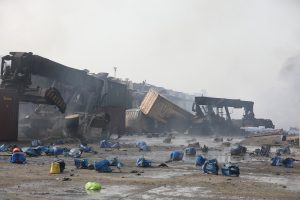Authorities in Bangladesh were still struggling Monday to determine the cause of a devastating fire that killed at least 49 people, including nine firefighters, and injured more than 100 others, officials and local media reported, as experts have raised concern over the safety standard in the country’s industrial sector.
Efforts to extinguish the fire at the BM Inland Container Depot, a Dutch-Bangladesh joint venture, continued overnight after the inferno broke out around midnight Saturday following explosions in a container full of chemicals.
Officials said the number of casualties rose over the weekend as many workers and firefighters were unaware of chemical storage at the depot, and after the initial fire they got close to the explosive containers. A few hundred workers and dozens of firefighters were attempting to extinguish the fire when the first explosion took place.
The depot is located near country’s main Chittagong Seaport, about 210 kilometers southeast of the capital, Dhaka, and it is one of 19 such depots in the region.
The latest fire has raised the concern over whether such facilities in Bangladesh, a burgeoning economy in South Asia, is maintaining safety standards.
Khairul Alam Sujan, vice president of Bangladesh Freight Forwarders Association, said Sunday that containers with hazardous chemicals were kept with those full of garment products ready for exports. He said it was important to maintain distance from containers with any hazardous chemicals.
Firefighters said more than one dozen containers had hydrogen peroxide, which helped spread the fire after the explosion, but it was not clear what caused the initial explosion.
Bangladeshi media were critical of the institutional capacity in ensuring safety at such facility.
“The fire … is the latest in an ever-growing list of tragedies that put Bangladesh’s appalling industrial safety record once again under the spotlight,” the Daily Star newspaper said in an editorial on Monday.
“The poor infrastructure and institutional preparedness for industrial safety … makes such fire incidents almost inevitable,” the Daily Star said.
The International Labor Organization said in a 2020 report that industrial safety in Bangladesh is very much in a nascent stage.
“A comprehensive framework covering all the safety-related issues across different sectors, economic activities and commercial establishments — with a reference to emergencies such as COVID-19 — needs to be developed,” it said.
The ILO said Bangladesh needs a “credible and accountable industrial safety governance structure.”
On Monday morning, authorities started collecting DNA samples from the family members of the people who died in the fire as burns made many of the bodies unrecognizable.
Explosives experts from Bangladesh’s military were called in to assist the firefighters. The explosions shattered the windows of nearby buildings and were felt as far as 4 kilometers away, officials and local media reports said.
The death toll remained 49 on Monday, according to Ekattor TV station. But the area’s civil surgeon said the number could still rise as the fire raged for a second night.
More than a dozen victims have been airlifted and brought to a specialized hospital in the capital, Dhaka. Prime Minister Sheikh Hasina expressed her shock at the accident and ordered adequate arrangement for medical treatment of the injured.
Bangladesh has a history of industrial disasters, including factories catching fire with workers trapped inside. Monitoring groups have blamed corruption and lax enforcement.
In the country’s massive garment industry, which employs about 4 million people, safety conditions have improved significantly after massive reforms, but experts say accidents could still occur if other sectors do not make similar changes.
In 2012, about 117 workers died when they were trapped behind locked exits in a garment factory in Dhaka.
The country’s worst industrial disaster occurred the following year, when the Rana Plaza garment factory outside Dhaka collapsed, killing more than 1,100 people.
In 2019, a blaze ripped through a 400-year-old area cramped with apartments, shops and warehouses in the oldest part of Dhaka and killed at least 67 people. Another fire in Old Dhaka in a house illegally storing chemicals killed at least 123 people in 2010.
In 2021, a fire at a food and beverage factory outside Dhaka killed at least 52 people, many of whom were trapped inside by an illegally locked door.

































